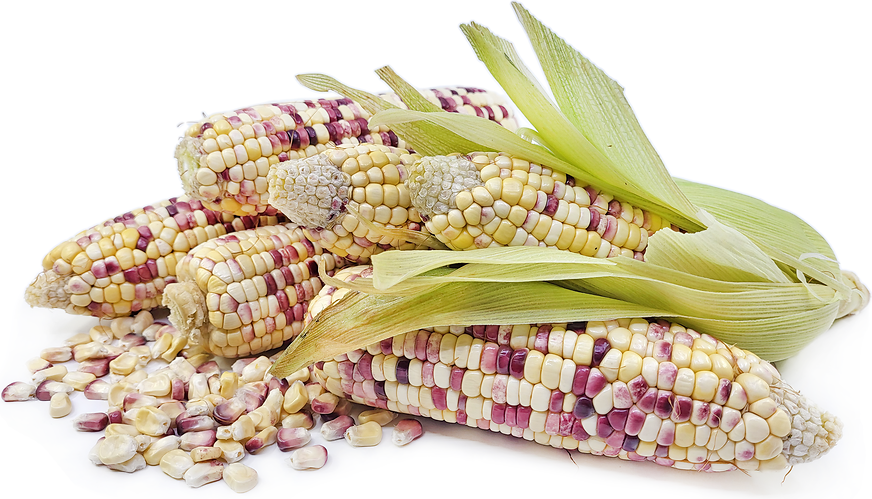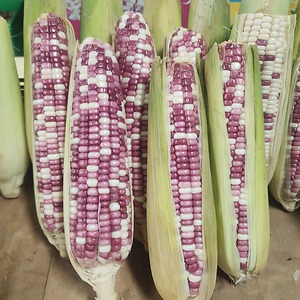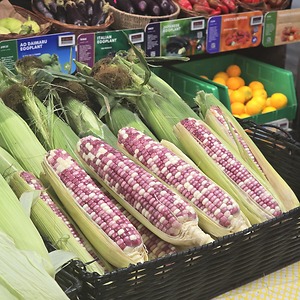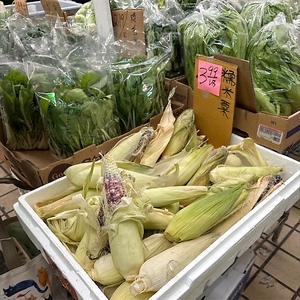


Purple Waxy Corn
Estimated Inventory, ea : 0
Description/Taste
Purple Waxy corn is a small to medium varietal, averaging 12 to 20 centimeters in length and 5 to 7 centimeters in diameter, and has a cylindrical, straight appearance. The cobs taper to a point on the non-stem end and have a flat stem end, encased in layers of a papery, fibrous, and sheath-like husk. The husks are generally pale green, turning brown and drying out with age. When the husks are removed, the cobs are covered in 12 to 15 rows of individual oval kernels. The fleshy kernels are tightly packed along the cob and have a smooth, thick, and semi-glossy surface. The kernels are also variegated in color, ranging from pale yellow, white, purple-white, maroon, to dark purple. Inside each kernel, the endosperm is shiny, aqueous, and starchy, giving off a waxy-like sheen, leading the corn to acquire its waxy moniker. It is important to note that Purple Waxy corn does not contain actual wax and should feel heavy for its size when selected. The variety must be cooked before consumption and develops a sticky, chewy, and toothsome texture with a neutral, sweet, and starchy flavor.
Seasons/Availability
Purple Waxy corn is available throughout the year in warm climates.
Current Facts
Purple Waxy corn, botanically classified as Zea mays var. ceratina, is a starchy type of corn belonging to the Poaceae family. The species was discovered growing as a natural mutation of dent corn crops cultivated in Asia, and over time, waxy corn was selectively bred for its chewy consistency and starch content. There are many different varieties of waxy corn, some with variegated coloring and some with solid kernel hues, but waxy corn, in general, is recognized by the kernel’s thick, starchy texture and the milky liquid that excretes from the kernels if punctured. Purple Waxy corn is primarily cultivated and consumed throughout Asia, but the corn has also been spread worldwide for commercial production, known as Glutinous, Sticky, and Asian corn. Waxy corn is traditionally cooked to develop a palatable texture and can be added to a wide array of culinary preparations. The corn is also used as a thickener in food products such as pies, frozen meals, soups, and dairy items, or it is incorporated into adhesives for envelopes, cardboard boxes, and glues.
Nutritional Value
Purple Waxy corn is a source of fiber to regulate the digestive tract and vitamin C to strengthen the immune system while reducing inflammation. The corn also provides some potassium to balance fluid levels within the body, vitamin K to assist in faster wound healing, and other nutrients, including magnesium, B vitamins, and vitamin E. One of the waxy corn’s distinct traits is its amylopectin content. Waxy corn contains almost 100% amylopectin, a type of starch comprised of water-soluble polysaccharide chains, giving the kernels their chewy nature. Common or yellow dent corn typically has 75% amylopectin and 25% amylose. Beyond starches, Purple Waxy corn contains anthocyanins, a pigment in the purple kernels that contributes antioxidant-like properties to protect the body against free radical damage.
Applications
Purple Waxy corn has a mild, subtly sweet, and neutral flavor well suited for cooked preparations. The kernels are customarily cooked to soften their tough and chewy texture and are served with flavorful spices and sauces. In Asia, Purple Waxy corn is incorporated into soups, stews, curries, salads, and porridge, or it is roasted and coated in lemon or lime juice, chile powder, butter, and salt. The corn can also be steamed, boiled, or pressured cooked and made into corn cakes, combined into egg-based dishes, or mixed with coconut milk and cream to make a sweet, chewy, and thick dish. In addition to culinary dishes, Purple Waxy corn can be processed and used as a starch to naturally thicken frozen foods, soups, dried sauce mixes, and pie fillings. Purple Waxy corn pairs well with vanilla, sugar, coconut milk, miso, butter, and soy sauce. Whole, husked, waxy corn will keep for 2 to 3 days when stored in a plastic bag in the refrigerator’s crisper drawer. Once cooked, the kernels will also hold 3 to 5 days in the fridge. Purple Waxy corn can be frozen for extended use.
Ethnic/Cultural Info
Waxy corn is an amylose-free corn, meaning it lacks a polysaccharide that makes up a type of starch that cannot be digested in the body. This type of starch is often avoided in Asia, as it is believed to cause digestive issues, leading waxy corn to be the preferred corn variety over sweet corn in Asian markets. This is similar to the consumption of glutinous, also known as sticky rice, instead of standard white rice. Waxy corn is the most popular type of corn cultivated and consumed in China. The cobs are typically boiled whole and are served as a fast-food snack, offered on city street corners through traveling food vendors. Waxy corn is also valued for its crisp, chewy texture. The corn’s consistency is similar to glutinous rice, boba, and mochi, a texture that is appreciated within Chinese cuisine.
Geography/History
Purple Waxy corn is native to China and was developed from dent corn varieties introduced from the Americas sometime before the 15th century. Some experts believe the Portuguese may have carried corn to Asia, while other experts argue it may have arrived earlier than that. Despite its ambiguous origins, corn was extensively cultivated as a cash and famine crop throughout Southeast Asia and Asia. Over time, some corn plants were noticed to have been altered by a natural genetic mutation, creating starchier kernels with a substantial texture, size, and flavor. These plants were selected for trials and cultivation, creating the many different types of waxy corn sold in commercial markets in the modern-day, including variegated Purple Waxy corns. Waxy corn was introduced to the United States in 1909, but the corn never became recognized as an essential product until World War II. During the war, starches such as tapioca were blocked from being sent from Asia into the United States, and waxy corn starch became the favored substitute for tapioca starch in recipes. Waxy corn has also been recently studied through plant research centers in Asia, especially in Thailand, developing new and improved varieties of Purple Waxy corn cultivars. Today Purple Waxy corn is grown worldwide and is widely used as a culinary ingredient in Southeast Asia, China, Korea, and Japan. The Purple Waxy corn featured in the photograph above was sourced from a local vendor at a market in Chinatown in Singapore.












